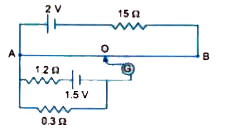A potentiometer is an ideal voltmeter since a voltmeter draws some current through the circuit while potentiometer needs no current to work. A potentiometer works on the principle of emf comparison. In working condition, a constant currant flows throughout the wire of a potentiometer is made of uniform material and cross-sectional area, and it has uniform resistance per unit length. The potential gradient depends upon the current in the wire.
A potentiometer with a cell of emf 2V and internal resistance 0.4Ω is used across the wire AB. A standard cadmium cell of emf 1.02V gives a balance point at 66cm length of wire. The standard cell is then replaced by a cell of unknows emf e (internal resistance r), and the balance. Point found similarly turns out to be 88cm length of the wire. The length of potentiometer wire AB is 1m.
The value of e is
The correct Answer is:D
Step by step video, text & image solution for A potentiometer is an ideal voltmeter since a voltmeter draws some current through the circuit while potentiometer needs no current to work. A potentiometer works on the principle of emf comparison. In working condition, a constant currant flows throughout the wire of a potentiometer is made of uniform material and cross-sectional area, and it has uniform resistance per unit length. The potential gradient depends upon the current in the wire. A potentiometer with a cell of emf 2 V and internal resistance 0.4 Omega is used across the wire AB. A standard cadmium cell of emf 1.02 V gives a balance point at 66 cm length of wire. The standard cell is then replaced by a cell of unknows emf e (internal resistance r), and the balance. Point found similarly turns out to be 88 cm length of the wire. The length of potentiometer wire AB is 1 m. The value of e is by Physics experts to help you in doubts & scoring excellent marks in Class 12 exams.
Updated on:21/07/2023Similar Questions
A potentiometer has uniform potential gradient. The specific resistance of the material of the potentiometer wire is 10−7 ohm-metre and the current passing through it is 0.1 ampere, cross-section of the wire is 10−6 m2. The potential gradient along the potentiometer wire is
View SolutionAs is the cross sectional area and rho is the specific resistance of a potentiometer wire. If I is the current passing through the potentiometer wire, then the potential gradient along the length of the wire is given by
View SolutionThe specific resistance and area of cross section of the potentiometer wire are ρ' and A respectively. If a current i passes through the wire, its potential gradient will be
View SolutionIf the resistivity of a potentiometer wire be ρ and area of cross-section be A , then what will be potential gradient along the wire
View SolutionA. Potentiometer measures the potential difference more accurately than a voltmeter, because the potentiometer
a. does not draw current from external circuit.
b. has a wire of high resistance.
c. draws a heavy current from external circuit.
d. has a wire of low resistance.
B. With the help of a diagram explain the principle of a potentiometer.
View SolutionA potentiometer has uniform potential gradient. The specific resistance of the material of the potentiometer wire is 10^(-7) ohm-meter and the current passing through it is 0.1 ampere cross-section of the wire is 10^(-6)m^(2) . The potential gradient along the potentiometer wire is
View Solution(i) State the principle of working of a potentiometer.
(ii) In the following potentiometer circuit AB is a uniform wire of length 1 m and resistance 10 Ω . Calculate the potential gradient along the wire and balance length AO (= l).

View SolutionAnswer the following: (i) State the principle of working of a potentiometer. (ii) In the following potentiometer circuit AB is a uniform wire of length 1 m and resistance 10Omega Calculate the potential gradient along the wire and balance length AO (=l)
View Solution
